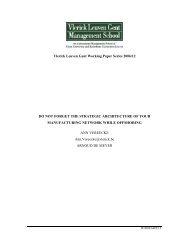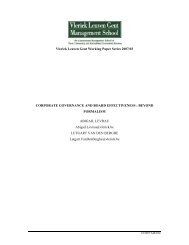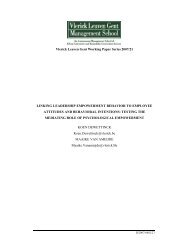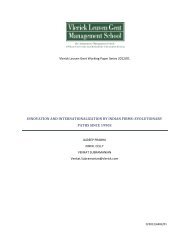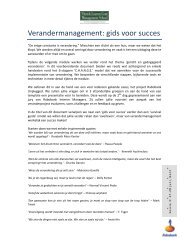an experimental investigation of the interactions ... - Vlerick Public
an experimental investigation of the interactions ... - Vlerick Public
an experimental investigation of the interactions ... - Vlerick Public
You also want an ePaper? Increase the reach of your titles
YUMPU automatically turns print PDFs into web optimized ePapers that Google loves.
For each supplier selection, subjects had to indicate <strong>the</strong>ir purchase intention for bothsuppliers by moving a slider over a horizontal bar. 6 By doing this, <strong>the</strong>y divided 100 points between<strong>the</strong> two new suppliers. The more points <strong>the</strong>y gave at a supplier, <strong>the</strong> higher <strong>the</strong>ir purchase intentionfor that supplier. If subjects were indifferent between both suppliers, <strong>the</strong>n both suppliers received 50points. Based on <strong>the</strong> subjects’ purchase intention, we constructed <strong>the</strong> dependent variable for ourstatistical tests. We tr<strong>an</strong>sformed <strong>the</strong> purchase intention to a scale from zero to 100 where zeroindicates <strong>the</strong> highest preference for <strong>the</strong> supplier that optimizes <strong>the</strong> perform<strong>an</strong>ce <strong>of</strong> <strong>the</strong> purchasingdepartment (i.e. supplier that causes <strong>the</strong> lowest total costs) <strong>an</strong>d 100 indicates <strong>the</strong> highest preferencefor <strong>the</strong> supplier that optimizes <strong>the</strong> perform<strong>an</strong>ce <strong>of</strong> <strong>the</strong> firm as a whole (i.e. supplier that optimizes<strong>the</strong> trade-<strong>of</strong>f between total costs <strong>an</strong>d revenue-generating possibilities). Thus, <strong>the</strong> higher <strong>the</strong> score forour dependent variable, <strong>the</strong> more subjects prefer a supplier that improves overall firm perform<strong>an</strong>ce.For our statistical tests, we take for each subject <strong>the</strong> average score <strong>of</strong> <strong>the</strong> six supplier selections. Wewill call our dependent variable <strong>the</strong> degree <strong>of</strong> firm-optimizing supplier selections.3.3 Experimental M<strong>an</strong>ipulationsThe incentive system is m<strong>an</strong>ipulated by providing particip<strong>an</strong>ts with <strong>an</strong> incentive to maximize<strong>the</strong> perform<strong>an</strong>ce <strong>of</strong> <strong>the</strong> purchasing department (i.e. minimize <strong>the</strong> total costs <strong>of</strong> a supplier) or tomaximize firm perform<strong>an</strong>ce (i.e. optimize <strong>the</strong> trade-<strong>of</strong>f between revenue-generating possibilities <strong>an</strong>dtotal costs). The department-based incentive formula is as follows:Total costs <strong>of</strong> a supplier – 10% <strong>of</strong> <strong>the</strong> revenues that a supplier will generate if he isselected.Subjects with <strong>the</strong> department-based incentive were informed that <strong>the</strong>y should focus onminimizing <strong>the</strong> value <strong>of</strong> <strong>the</strong>ir incentive formula (i.e. minimizing total costs <strong>of</strong> a supplier). The firmbasedincentive formula is as follows:<strong>an</strong>d in two supplier selections <strong>the</strong> total costs <strong>of</strong> one supplier was higher while <strong>the</strong> total costs <strong>of</strong> <strong>the</strong> o<strong>the</strong>r supplier waslower compared to <strong>the</strong> current supplier. Within each group <strong>of</strong> two supplier selections, <strong>the</strong>re was one (one) supplierselection in which <strong>the</strong> total costs <strong>of</strong> both new suppliers were in a small (large) r<strong>an</strong>ge around <strong>the</strong> total costs <strong>of</strong> <strong>the</strong> currentsupplier.6 Marketing research has already shown that purchase intention scales are good predictors <strong>of</strong> real buying behavior (Wrigth<strong>an</strong>d MacRae 2008).14



